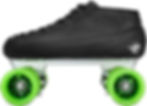Here's the Need-to-Know for beginners on roller skates and inline skates 🛼
- Jennifer Yonda
- Jan 2
- 6 min read
Updated: Nov 14
Hey there, future skater! As the founder of Skate Hunnies and an avid inline skater, I'm stoked to help you navigate the wonderful world of skating equipment. Whether you're looking to cruise the beach, dance at the rink, or just get rolling, this guide will help you make informed choices about your first set of wheels.
Rollerblades vs. Roller Skates: What's Your Vibe?
Here's the Need to Know for Beginners on Roller Skates and Inline Skates to help choose your perfect pair of skates.
Let's break down the main differences between these two awesome styles.
Roller Skates

The queens of the roller rink - made for smooth, groovy movements
Built for dance moves and rhythm-based skating
More stable for side-to-side movement
Super versatile - just swap to outdoor wheels for road skating
Deep connection to music and dance culture

Inline Skates (Rollerblades)
Perfect for those beach-side cruises, road skating, and long-distance adventures
Great stability for forward and backward movement
Excel at outdoor skating and handling various terrain
Generally faster than traditional roller skates
More Info on Roller Skates: Finding Your Perfect Roller Skate Match 🎯
Different skates are designed for different activities - here's a quick guide to help you find your perfect match:
Park Skates

Built super tough with reinforced ankle support and aluminum plates
Wide trucks for better stability on ramps and transitions
Adjustable toe stops for stalls and drops
Perfect for: Bowl skating, ramps, jumps, and aggressive tricks
Derby Skates
Low-cut boots for maximum ankle mobility and quick movements
Lightweight but durable construction for high-impact skating
Shorter wheelbase for tight turns and quick direction changes
Perfect for: Roller derby, agility skating, and speed games
Indoor Skates

High boot design with strong ankle support for precise control
Harder wheels (95A-103A) for smooth rolling on rink floors
Mounted toe stops for spins and dance moves
Perfect for: Dance skating, artistic routines, rhythm skating
Outdoor Skates

Weather-resistant materials with flexible ankle support
Wider trucks for stability on various surfaces
Softer wheels for shock absorption (more on this below!)
Perfect for: Trail skating, cruising, beach boardwalks
Speed Skates

Low-cut, minimalist design for reduced weight
Longer wheelbase for stability at high speeds
Precision bearings and specialized wheels
Perfect for: Racing, distance skating, pace skating
If you’re planning to skate outdoors: All About Outdoor Wheels 🛞
Here's the scoop on outdoor wheels - they're a game-changer for street skating! Outdoor wheels are softer (usually 78A-85A durometer) and act like tiny shock absorbers for your skates. They'll eat up those sidewalk cracks and pebbles that would normally send you flying. If you're skating outside, these aren't optional - they're essential for a smooth, safe ride.
The Bottom Line: Real Talk About Your First Skates
Here's the Need-to-Know for beginners on roller skates and inline skates, real talk. If you're just starting out, I'd recommend either a quality outdoor skate or an indoor/artistic skate with two sets of wheels (indoor and outdoor). This gives you the flexibility to try different styles while you figure out what you love most.
Remember:
Don't go too cheap on your first pair - poorly made skates can be dangerous and frustrating to learn on
Make sure your skate has an aluminum plate (avoid plastic plates!)
Consider buying a skate that can grow with your skills
More Info for Inline Skates: Finding Your Style 😏
Just like roller skates, inline skates come in different styles for different types of skating. Here's a quick breakdown:
Urban/Freeride Skates

Hard shell boot with superior ankle support
Highly maneuverable with shorter frames
Often have brake-removal options
Perfect for: City skating, tricks, stair-bashing
Fitness/Recreation Skates

Comfortable soft boot design
Longer frames for stability and speed
Usually come with a heel brake
Perfect for: Beach cruising, fitness skating, casual rides not recommended
Speed Skates

Low-cut, light weight carbon boot for maximum power transfer
Extra long frames for stability at high speeds
Bigger wheels (100-125mm) for efficiency
Perfect for: Racing, marathon skating, distance training
Aggressive Skates

Tough hard boot with heavy-duty soul plates
Shorter frames with grind spaces
Smaller wheels (58-62mm) for better control
Perfect for: Skate parks, grinds, jumps, street tricks
Slalom Skates

Precise fit with heat-moldable shells
Rockerable frames for tight maneuvers
Medium-sized wheels (76-80mm)
Perfect for: Technical skating, cones, dance moves
A note about Hard boots vs Soft boots:
If you're going the inline skate route, here's a pro tip: go for a hard boot over a soft boot! Here's why:
Your ankles will thank you - they provide superior support and protection
They're basically the Honda of skates - they'll last forever
Perfect for progression - when you're ready to try jumps or advanced moves, your boots will be too
Want to Learn More?
Looking for more info about the different types of inline skates? Here’s a great article comparing options on metrics like affordability, quality, and use case.
Where to Shop
Local tip alert! 🚨 If you're in the LA area, there's this amazing skate shop in Santa Monica run by Mick, a true skating legend who's dedicated his life to the sport. Trying on skates before buying them is super helpful, and Mick's expertise is invaluable.

🛍 Intuition Skate Shop
📍 303 Pico Blvd, Santa Monica, California
📞 (661)-323-6293
🔔 Make sure to check the shop hours before going!
If you can’t make it in to a physical shop, Inline Warehouse is the go-to online option.
Safety First: Protective Gear Recommendations🪖
Listen up, because this is super important! Whether you're a beginner or a pro, protective gear isn't optional - it's essential. We recommend getting a helmet and pad set (knee, wrist & elbow pads) that you love. Let's talk about what you need and why quality matters:
Recommended Brands
When it comes to protection, Triple 8 and 187 Killer Pads are top-tier choices. Both brands are trusted by pros and have years of experience keeping skaters safe. Here's what you need:
Helmet (certified for skating)
Knee pads (we don’t recommend soft pads)
Wrist guards (very important!)
Elbow pads (these usually come in a set with wrist guards and knee pads, and although less likely to get bumped, still worth protecting!)
Pro tip: Don't skimp on protective gear! The money you "save" on cheaper pads isn't worth the bills from a bad fall. Both Triple 8 and 187 make gear that'll last you ages and actually protect you when you need it.
Types of Knee Pads (And Why They're Not All Created Equal)
Real talk: Those soft, sleeve-style knee pads you might see at general sports stores? They're not gonna cut it for skating. Here's the breakdown:
Soft Knee Pads (Not recommended)⛔
These are basically just fabric with light padding
Offer minimal impact protection
Will not protect you from real falls
Recreational Knee Pads ⚠️
Basic hard-shell protection
Good for casual cruising
Might need replacing sooner
Okay for beginners on smooth surfaces
Park/Pro Knee Pads ✅
Heavy-duty protection with thick padding
Durable hard shells that can take repeated impacts
Perfect for learning new skills (you will fall!)
Worth the investment for any serious skater
My Personal Setup

I rock the FR2 80 skates from FR Skates, and I'm obsessed with their versatility! The coolest feature? The rockerable frame lets me switch between a stable flat setup and a more playful rockered position (think banana-shaped wheel profile). This gives me the best of both worlds - I can cruise efficiently but also bust out some dance moves like I'm on roller skates!
Questions? Let's Chat!
Still got questions? I'm here to help! Shoot me an email at hello@laskatehunnies.com - I love connecting with future skaters and helping you find your perfect ride.
Remember, every skater started as a beginner, so don't be afraid to ask questions and take your time finding the right setup. See you on the streets (or at the rink)! 🛼✨
Hope to see you out there 🛼
Jen Yonda
Founder of the Skate Hunnies





